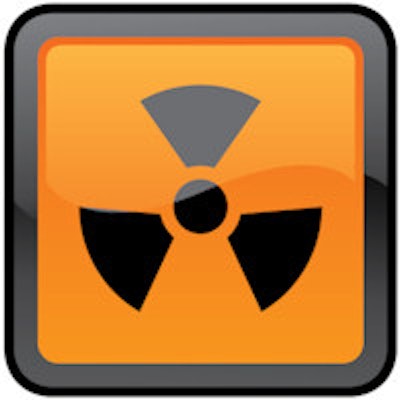
A study of occupational radiation dose and errors in film badge use by CT staff at a university hospital in Iran found that radiation exposure remained low and errors declined over a 20-year period, despite an annual increase in the number of patients undergoing scans.
Study author Hamid Behroozi, from the department of radiology technology at the University of Medical Sciences in Ahvaz, Iran, reviewed data collected over a 20-year period at a general teaching hospital (Radiography, September 13, 2013). He found that on the whole, radiation dose remained low and errors were few, particularly after the hospital assigned a health physicist to be responsible for badge use.
Radiation's effects on workers
The deleterious health effects of radiation to both patients and radiation workers became known in the 10 years or so after Wilhelm Conrad Roentgen's discovery of x-rays in 1895, Behroozi wrote. Film badges are the most common type of personal monitor used to track ionizing radiation among healthcare personnel, but their use can be hindered through errors such as negligence, lack of sufficient knowledge, or deliberate efforts to keep monitored results below a threshold.
The issue has become particularly important with the rise of more powerful imaging modalities such as CT, which produces greater radiation dose per study than conventional x-ray imaging. Previous studies have looked at the range of occupational doses received by medical imaging staff, but occupational dose associated with CT department staff has not specifically been evaluated, Behroozi noted.
He collected and analyzed 95 film badge reports containing approximately 400 occupational doses to CT staff, produced between November 1990 and October 2009. Of the six CT departments under the umbrella of the university, only one was included in the study as it was the only one with personnel dosimetry files from the past 25 years.
Behroozi examined the number of staff members who received a radiation dose of less than 0.05 mSv and those who received a dose of more than 0.05 mSv. He also tallied the number of staff who received an annual average dose of more than 0.05 mSv, as well as the number and types of mistakes involved in using the film badges.
The radiation workers whose film badge reports were assessed consisted of radiologic technologists, radiology residents, and radiologists. Behroozi also obtained and recorded the number of patients who had a CT scan during the 20-year period.
He found that most of the CT staff (83%) received a radiation dose of less than 0.05 mSv per year, within the annual occupational dose limits. The number of errors related to badge use also declined during the study period.
Some of the staff received an annual radiation dose of more than 0.05 mSv, but these personnel were found to have been using the same film badge when performing other x-ray imaging procedures such as angiography, fluoroscopy, and CT-guided biopsy. In this group, the annual average effective dose was 0.73 mSv, with a range of 0.15 to 1.55 mSv.
Types of mistakes
Among the types of mistakes reported for badge use, the most common involved issues of wearing the film badges. This type of mistake rose in 1994 and went up to six in 1995 and 1996. Mistakes then decreased to 0 from 1999 to 2009, Behroozi found.
The second most common mistake was the film badge not being sent back to the institution or being sent back later than the due date, while a less frequent mistake was the film badge being spoiled by moisture.
Behroozi noted that the above trends occurred as the department experienced 10% annual growth in the number of patients referred to the CT department at the hospital, from 13,786 in 1990 to 44,210 in 2009.
Training affected correct badge use, according to Behroozi. At one point during the study period, the institution did not have a single individual directly responsible for managing film badges. After a department health physicist was assigned to be responsible for managing film badges and in-service training, the number of mistakes fell to 0 in 2004.
"In spite of an annual increase in the number of patients undergoing radiological procedures, within the 83% of the radiation workers identified during the period evaluated, there has been a decrease in the frequency of errors," Behroozi concluded. "This decrease has occurred whilst maintaining a radiation dose < 0.05 mSv. The results indicate that occupational radiation protection has improved. The improvement is considered to result from improved management and systems and protocols of alterations."




















